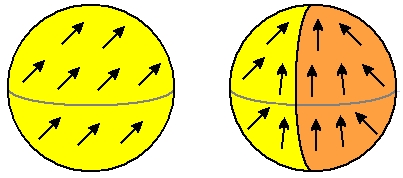Entanglement is a peculiar feature of quantum physics where two or more quantum objects are coupled in a special way so that they act effectively as parts of the same entity. Entangled states is a key ingredient for quantum computing which holds a promise to outperform traditional computing due to a high degree of parallelization offered by entanglement. Researchers at the University of Nebraska MRSEC explore the use of spin waves in magnetic nanoparticles as a robust system for quantum computing. A key requirement is the controllability and characterization of the entanglement between the spin-waves modes. A figure below shows a schematic example of two spin states in a nanosphere. The superposition of these states is proven to contain entanglement that is sensitive to the local magnetic field – a feature that can be used for the pre¬paration and measurement of entanglement. The researchers calculated the degree of entanglement as a function of the external magnetic field and the size of the nanosphere and showed that the entanglement decreases with the field. This result implies that spin waves in magnetic nanoparticles can be used to realize quantum entanglement.

Two spin states in a magnetic nanosphere: a unifom mode (left) and a nonuniform mode (right). A superposition of these modes represents an entangled state.